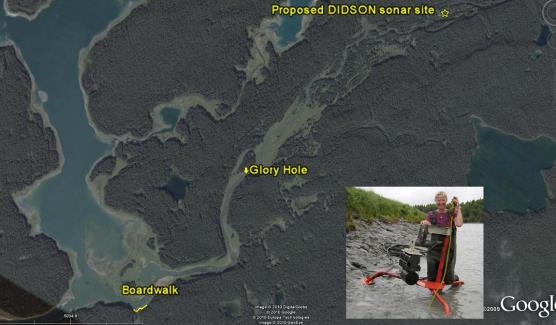News Release Date: December 10, 2010
Contact: Allison Banks, 907-697-2611
Why investigate Bartlett River salmon returns?
The Bartlett River is a popular recreational fishing destination. Creel surveys during 1996-98 estimated recreational coho harvest at 400-800 fish annually. Angler counts since 2005 indicate a two-fold increase in angling effort over the past decade. Although current harvests of sockeye and coho are not well known, harvest has likely doubled. With Alaska Marine Highway System service to Gustavus beginning this year and new regulatory changes to the charter halibut fishery, stream fishing effort and salmon harvest rates are anticipated to increase. The ability of the Bartlett River sockeye and coho populations to sustain this increasing level of harvest is unknown.
The NPS has been studying coho and sockeye salmon in the Bartlett for several years to determine the feasibility of different salmon escapement estimation methods. But turbid water quality and poor visibility, especially during fall rains, make fish counts and identification very difficult. DIDSON sonar, in contrast with other methods, is the best alternative to estimate escapement because it works in poor visibility, doesn't delay fish migration or aggregate fish (enabling excessive predation), and minimizes impacts in park designated wilderness.
What will Dual frequency IDentification SONar (DIDSON) actually do?
A portable DIDSON sonar unit installed directly in the stream creates an ensonified field through which the migrating fish pass. Temporary fencing along both banks will direct the fish into this field so "near video" quality images can be accurately recorded as fish pass by the sonar "camera." A laptop stores all data until biologists can review the images and fish can be identified and counted. A clean, quiet, 65 watt EFOY fuel cell would power the installation. Over the four year study (2011-2014), equipment would be put in place from June through October and removed the rest of the year. The sonar would be installed about 2 miles above where most angling activity occurs. See Map
Because the number of sockeye and coho salmon spawning each year within this river system is not well known, this information would provide a baseline against which future changes in fish abundance can be compared and overharvest avoided.
What's Next?
The NPS is asking for your comments and ideas on this proposal so they can be considered early in the effects analysis process of an Environmental Assessment (EA). Potential issues to be discussed include wilderness quality and character, impacts to coho and sockeye salmon, impacts to visitor use and quality of experience, concerns over equipment maintenance and operation, and protection from wildlife. Your comments will be most useful if they are received by January 15, 2011. An EA analyzing the potential effects of DIDSON installation and other alternatives will be prepared this winter. A 30 day public review of the environmental assessment could take place by March, 2011. Following this the NPS would consider comments and analyze any additional potential impacts raised by these comments. The project is proposed for May 2011.
For more information about the proposed DIDSON sonar installation and Bartlett River salmon research, please contact Fisheries Biologist Chad Soiseth at 907-697-2659. Please submit your comments to Allison Banks at Allison_Banks@nps.gov or by mail at: Glacier Bay National Park and Preserve, P.O. Box 140, Gustavus, AK 99826 or online through this link.

